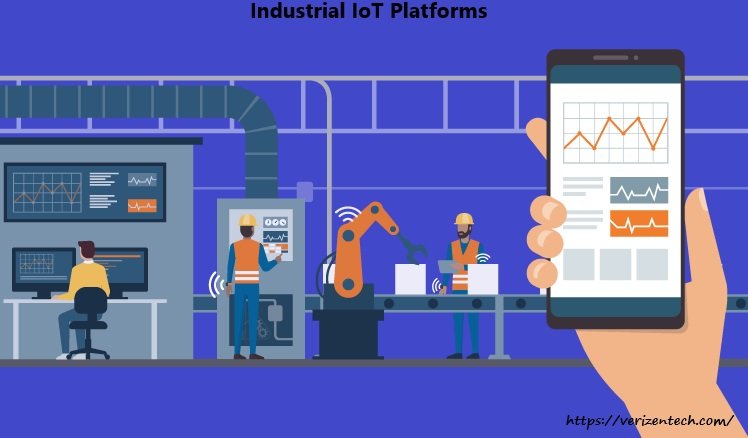In today’s rapidly evolving manufacturing landscape, the integration of cutting-edge technologies is transforming traditional processes. One of the most significant advancements in this field is the rise of Industrial IoT (Internet of Things) platforms. “Industrial IoT Platforms” are pivotal in driving digital transformation in manufacturing, enabling companies to optimize operations, reduce costs, enhance productivity, and improve decision-making processes.
What are Industrial IoT Platforms?
Industrial IoT platforms are integrated software solutions that connect, manage, and monitor a network of IoT devices in an industrial environment. These platforms facilitate seamless communication between machines, devices, and sensors, enabling real-time data collection, analysis, and visualization. By leveraging the power of data analytics, machine learning, and artificial intelligence, Industrial IoT platforms help manufacturers make informed decisions, optimize processes, and predict maintenance needs.
Unlike consumer IoT platforms, which focus on personal and home automation devices, Industrial IoT platfor are specifically designed to meet the demands of industrial applications such as manufacturing, supply chain management, and asset management. They offer scalability, robustness, security, and reliability, which are critical for industrial environments.
Key Components of Industrial IoT Platforms
An effective Industrial IoT platform comprises several key components, each serving a specific function in the data lifecycle:
- Device Management: This component manages the lifecycle of connected devices, including onboarding, configuration, monitoring, maintenance, and decommissioning. It ensures that all devices are functioning optimally and securely.
- Data Ingestion and Integration: The platform must be capable of collecting vast amounts of data from various sources, such as sensors, machines, and enterprise systems. Data integration capabilities enable seamless connectivity between different systems, ensuring that data flows efficiently across the network.
- Data Storage: Industrial IoT platforms require scalable storage solutions to handle the massive volumes of data generated by IoT devices. Cloud-based, on-premises, and hybrid storage options allow flexibility in storing and managing data.
- Data Processing and Analytics: Once data is collected, it must be processed and analyzed to extract valuable insights. This component utilizes advanced analytics, machine learning, and artificial intelligence to identify patterns, trends, and anomalies, which can be used for predictive maintenance, quality control, and process optimization.
- Application Enablement: This layer allows developers to build, deploy, and manage custom applications that leverage IoT data for specific use cases. Application enablement environments often provide APIs, SDKs, and tools that simplify the development process.
- Security and Compliance: Ensuring the security of data and devices is paramount in industrial environments. Industrial IoT platforms include robust security measures, such as encryption, authentication, and authorization, to protect against cyber threats and ensure compliance with industry standards and regulations.
- User Interface and Visualization: A user-friendly interface allows operators, engineers, and decision-makers to interact with the platform, visualize data, monitor key performance indicators (KPIs), and take actionable steps based on insights.
Benefits of Industrial IoT Platform in Manufacturing
Industrial IoT platforms offer numerous benefits that drive efficiency and innovation in modern manufacturing. Some of the key advantages include:
- Enhanced Operational Efficiency: By connecting and monitoring machines and processes in real time, manufacturers can identify bottlenecks, reduce downtime, and optimize production lines. This leads to improved overall equipment effectiveness (OEE) and reduced operational costs.
- Predictive Maintenance: Traditional maintenance methods are often reactive and costly. manufacturers can implement predictive maintenance strategies that leverage data analytics to predict equipment failures before they occur. This reduces unplanned downtime, extends equipment life, and minimizes maintenance costs.
- Improved Quality Control: IoT sensors and data analytics enable real-time monitoring of production quality, helping manufacturers detect defects and deviations early in the process. This reduces scrap rates, ensures consistent product quality, and enhances customer satisfaction.
- Supply Chain Optimization: Industrial IoT platforms provide visibility into the entire supply chain, from raw material sourcing to finished product delivery. By monitoring inventory levels, production schedules, and logistics, manufacturers can optimize supply chain operations, reduce lead times, and respond more effectively to demand fluctuations.
- Energy Management: Monitoring energy consumption across machines and processes allows manufacturers to identify energy inefficiencies and implement strategies to reduce energy usage, lower costs, and reduce their carbon footprint.
- Remote Monitoring and Control: Industrial IoT platform enable remote monitoring and control of machinery and equipment. This is particularly beneficial for large-scale manufacturing operations or geographically dispersed facilities, as it allows operators to monitor performance and make adjustments without being physically present.
- Faster Time-to-Market: By leveraging real-time data and automation, manufacturers can streamline their product development and production processes. This enables them to respond quickly to market demands and bring new products to market faster.
Use Cases of Industrial IoT Platform in Manufacturing
The applications of Industrial IoT platforms in manufacturing are vast and varied. Here are some notable use cases:
- Smart Factories: In a smart factory environment, sensors, and devices create a highly automated and flexible production system. This enables manufacturers to dynamically adjust production lines, reduce downtime, and optimize processes for greater efficiency.
- Digital Twins: A digital twin is a virtual replica of a physical asset, process, or system. enable the creation of digital twins that provide real-time insights into the performance, health, and behavior of machines. This helps manufacturers simulate different scenarios, predict potential failures, and optimize asset utilization.
- Predictive Quality Analytics: By collecting and analyzing data from production lines, manufacturers can use Industrial IoT platforms to predict quality issues before they occur. This helps in reducing rework, improving product quality, and minimizing wastage.
- Condition-Based Monitoring: IoT sensors installed on critical equipment continuously monitor parameters such as temperature, vibration, and pressure. Industrial IoT platforms analyze this data to identify deviations from normal operating conditions and trigger alerts for preventive maintenance.
- Augmented Reality (AR) for Maintenance: Industrial IoT platforms can be integrated with AR applications to assist maintenance technicians. Technicians can use AR glasses or tablets to view real-time data, receive step-by-step instructions, and visualize the internal workings of machines, enhancing maintenance efficiency.
- Asset Tracking and Management: Industrial IoT platforms provide real-time visibility into the location, condition, and status of assets across the supply chain. This helps manufacturers optimize inventory management, reduce theft and loss, and improve overall asset utilization.
Challenges in Implementing Industrial IoT Platform.
While the benefits of Industrial IoT platforms are substantial, there are several challenges that manufacturers must address to ensure successful implementation:
- Data Security and Privacy: The proliferation of connected devices increases the risk of cyber-attacks and data breaches. Manufacturers must implement robust cybersecurity measures to protect sensitive data and ensure compliance with regulations.
- Integration Complexity: Integrating Industrial IoT platforms with existing systems, such as ERP, MES, and SCADA, can be complex and time-consuming. Ensuring seamless data flow between systems requires careful planning and execution.
- Scalability: As manufacturers expand their IoT deployments, the platform must be scalable to accommodate additional devices, data, and users. Choosing a platform that offers flexibility and scalability is crucial for long-term success.
- High Initial Investment: The initial cost of implementing Industrial IoT platform, including hardware, software, and infrastructure, can be significant. Manufacturers need to carefully assess the return on investment (ROI) and develop a phased implementation strategy to minimize costs.
- Data Management: The sheer volume of data generated by IoT devices can be overwhelming. Manufacturers need to implement effective data management strategies to ensure that valuable insights are not lost in the noise.
- Skills Gap: Implementing and managing Industrial IoT platform requires a workforce with specialized skills in data analytics, cybersecurity, and IoT technology. Investing in training and development programs is essential to bridge this skills gap.
Future Trends in Industrial IoT Platform.
The future of Industrial IoT platforms in manufacturing is bright, with several emerging trends poised to reshape the industry:
- Edge Computing: As the volume of IoT data continues to grow, edge computing is gaining traction. By processing data closer to the source, edge computing reduces latency, enhances real-time decision-making, and reduces the load on central cloud servers.
- Artificial Intelligence and Machine Learning: AI and ML are becoming integral components of Industrial IoT platforms. These technologies enable advanced analytics, predictive maintenance, and automated decision-making, further enhancing the efficiency of manufacturing processes.
- 5G Connectivity: The rollout of 5G networks will significantly enhance the capabilities of by providing faster data transmission, lower latency, and increased network reliability. This will enable more connected devices and enhance the performance of real-time applications.
- Blockchain for Supply Chain Transparency: Blockchain technology is being explored to enhance transparency, security, and traceability in supply chain operations. Integrating blockchain can help manufacturers ensure the authenticity and integrity of data across the supply chain.
- Sustainability and Green Manufacturing: With increasing focus on sustainability, are being leveraged to optimize energy consumption, reduce waste, and minimize the environmental impact of manufacturing processes.
Conclusion
Industrial IoT platforms are revolutionizing modern manufacturing by enabling smarter, more connected, and more efficient operations. From predictive maintenance and quality control to supply chain optimization and smart factories, these platforms are driving digital transformation across the industry. However, successful implementation requires careful planning, robust security measures, and a skilled workforce.
Also, Read About, Top IoT Trends to Watch in 2024.




